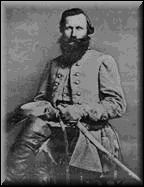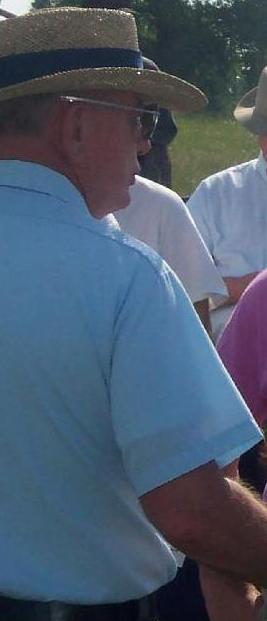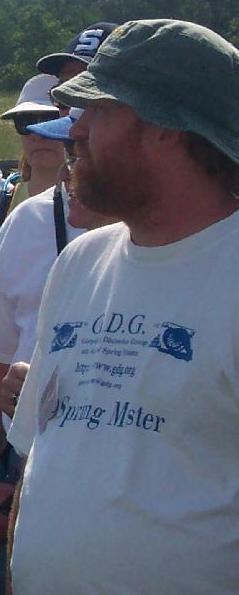

 |
 |
Since Stuart's cavalry had been screening his army with actions at Aldie,
Middleburg and Upperville, only ending on the 22nd and through
those actions and the week before, the horses were subsisting by grazing
rather than a proper diet of oats and forage, so they were losing
condition each day. Stuart's orders to proceed on his ride had him
setting out on the 24th which wasn't enough time to get any of the
animals in condition before the expedition whichever route he took.
Stuart's report mentions that horses were breaking down on the 26th
which was only one full day on the road which indicates than some if
not all of the animals were in poor shape to begin with. So we have a
situation where he has orders that in reality could not be complied
with given the state of the animals giving him the "Hobson's choice" of
telling army HQ that he can't perform the mission or trying to do what
he could with what he had. Neither was a viable choice yet he had to do
something. He had no resupply of horses given the method the ANV used
for remounts so he had to make do with the animals on hand many of which
were obviously jaded and needed a week or better of good food and rest
but that wasn't going to happen. I think that a good case can be made
that there was a case of optimism both on Stuart's part and Army HQ
about his capabilities in late June and while Stuart himself bears some
of the responsibility there is blame enough to pass around to others
who should have been able to puzzle out the fact that the horses weren't
getting what was needed to keep working which for Stuart's immediate
command was 45,000-50,000 pounds of oats per day. An amount the ANV
logistics system was never able to furnish.
Regards,
Wayne
Given where Stuart needed to be on the right flank of his army as per
Lee's orders how does he abandon his ride and get there. There, being
scouting a line roughly along the PA/MD border with Hanover as a rough
center since that's where the right flank is. A suggested route please
from Haymarket where he ran into Hancock. Conversly a route from the
AMU area if we want to go back to the 24th. If we score Stuart for what
he
did we need to provide some useful alternatives.
Regards,
Wayne
Esteemed member DPowell334@aol.com contributes:
I have come to believe that Lee was intentionally taking a large gamble
that he could get his army well north of the Union army, re-concentrated,
and then
wait to pounce on the Federals as they came north.
Lee scattered his men quite a bit, and in marked constrast to the year
before, paid no attention to the South Mountain gaps in Maryland. In order
to
catch him, the Federals had to open up their columns and move out on
parrallel roads as well.
What I think Lee expected to do was gain a day or two of rest in PA,
and reconcentrate all of his army against one wing of the Federals. With
Stuart
in place, he could monitor the progress of the Federals and choose
which wing to hit. What happened, of course, is that Stuart did not get
there, Lee
became uncertain, and what should have been a dynamic converging attack
on July 1st turned into a reluctant ANV effort that Lee spent a good deal
of
time that day trying to stop, or at least limit.
Stuart had the discretion, of course, to do what he did - it was well
within Lee's intentions. What Stuart is guilty of is making a tactical
mistake - he
should have turned back to the northwest on the 25th, instead of heading
20 miles futher south to the Occoquon and Wolf Run Schoals. That decision
meant
he could not possibly be where he was supposed to when Lee wanted him
there.
Wayne is correct about the horses, and the grain issue is one of the reasons I feel that capturing the wagons actually helped Stuart, instead of hindering him - for the first time in many days, they had grain to feed, and could forgo the long (5-6 hours) pauses to gather grass that had distinguished the first few days of the trip.
Grain or no, it was a hell-ride, as the accounts of those who lived through it show. It really broke down the cavalry at a critical time.
Dave Powell
Dave,
In my map exercise I assume Hanover to be the destination and given
the roads available Hanover is only 16 miles longer than Gettysburg for
a
central position so less than a day can be gained. The distance from
Haymarket via the actual route taken is 108 miles and would have been
nearly identical to Gettysburg. The distance to reverse and go up the
valley to Gettysburg is 126, no shorter route there. Grazing up the
valley route would have been poor to non-existant with the number of
animals which were ahead of him on that route not to mention the crowded
roads which would in all probability hindered travel to an extent.
Another minus to the valley route is the complete loss of contact with
the Federals
which we know with hindsight happened on the route he chosebut that
was not evident on the AM of the 25th. The bottom line it seems
to me is that as of the AM of the 25th when he recoiled off of the
II corps there wasn't time left to get where he needed to be in time to
be
useful, given the distances involved and the condition of the animals.
Regards,
Wayne
Agreed, but his choice to go on only compounded the problem.
I am not arguing that the western route was a good choice, Wayne, only
that it was the better choice than turning south to the Occoquon. I think
that
turn south was a bad mistake.
Dave Powell
Dave,
It seems to me that neither choice open to Stuart on the AM of the 25th
was going to do the job required. The western route slightly longer and
more crowded than the eastern. Then there is the "lost order" quoted
by H.B. McLellan indicating that the western route might be the slower
due to congestion. Given the distances involved and a normal rate of march
for cavalry in good shape at the onset I just don't see Stuart getting
where he needs to be in the
time available by either route.
Regards,
Wayne
But that is not the question, I think. We agree that he was badly out
of place by the 25th, and had little chance of fulfilling Lee's intentions
to
the letter.
While neither route is good, do you think that the Occoqoun route is
better, and there for the better military decision, than turning back and
trying to
remain in contact with Lee? I simply do not get that.
Remember, a significant advantage of the western route is that Stuart
never loses communications with Lee. Robertson and Jones, for example,
were in
daily contact with the ANV HQ using this route.
So which is the better military decision? East or West? I vote west.
Dave Powell
Esteemed member Wayne Wachsmuth contributes:
Dave,
The question is not which is the better route and maintaining contact
with his army while moving up the valley, while a good thing is not his
primary mission. That was to place himself on the right flank of the
ANV and provide recce and a screen against the AOP. The valley route would
not do that in the time frame required and we know that the actual
route did not either. That is why I have come to the position that as of
the
AM of the 25th Stuart is facing a "Mission Impossible" situation where
neither of the two choices available to him will allow him to fulfill
his mission which must after all be to scout the positions of tha AOP,
which he cannot do from the valley and provide recce to his army and
harass the advance of the enemy. To do those things he must be on that
line near the PA/MD border east of South Mountain and he couldn't get
there in time either way.
Regards,
Wayne
I don't agree.
First, I think you have defined the mission too absolutely. Stuart's
original mission was to put himself on the right flank of the army - an
idea conceived
on June 24th, when Lee envisioned the right flank to be York PA. If
Stuart takes his historical course, he cuts himself off from Lee and any
chance to
modify or amend those orders. Hence, the only way Stuart can fulfill
his mission is to reach York or thereabouts within the time frame. I also
think
this is impossible.
What you are omitting, however, is to give Lee any chance to amend those
orders as the mission unfolds and Stuart falls behind schedule. If Stuart
stays west of the AOP, then every day that passes Lee can amend the
orders to fit the situation. This is a huge advantage, and the main reason
why I feel
that Stuart made the wrong choice.
Moving up the Valley allows Stuart to cross at Williamsport, and occupy
Dave,
That route you describe is the one that measures a bit longer that the
actual distance covered on his eastern route. How will he ba able to
gain any ground whether he can talk with Lee or not? The distance stays
the same. The horses are still in the same poor shape and were failing
in the first 24 hours on the road.
Well, the time saved is in not tearing up RR tracks, paroling prisoners,
trying to figure out where the Federals are at Hanover and getting around
them, chasing around to Carlisle looking for a missing army corps,
etc.
If you look at how Stuart covered that distance, it strikes me that
he covered the last half of it in something like 50 hours - that, more
than any
thing, broke down the animals. Certainly the troopers got no sleep
in the last couple of days. I think a more reasonable march would save
a great many
- not all, but a great many - horses.
And even your time frame has Stuart arriving in the Fairfield area by
the 29th or 30th - but in contact with Lee, undoubtedly in contact with
the
Federals:) I see that as a great advantage to Lee.
Again, though, I am not arguing that Stuart could have fulfilled his
original orders this way - merely that of his two choices by the afternoon
of the
25th, going back to the west was a far better one than turning south.
Dave Powell
Esteemed member Wayne Wachsmuth contributes:
Dave,
Much of what you say is true but it also is based on what we as students
of the campaign know, not the information that Stuart had on the 25th.
He had as I see it a "coin toss" as to which route to choose when his
planned avenue was blocked by II corps. I think that he figured he could
still pull it off since his new path was still the shorter distance
to York which according to his report was his destination. Then "friction"
took a hand and the inevitable delays happened. Delays that both he
and his commander should have made allowances for but did not. After that
the rest of the scenario played out with Stuart & Co. being little
more than bit players.
Regards,
Wayne
So the horses had to subsist by grazing and that according the my neighbor
[US Army Col.(Ret)] who speaks horse cavalry would take 6-10 hours per
day IF
decent grazing can be had. So all in all the horses would have in all
probability been losing condition constantly up to and including the
Dave Powell
Again that depends on availability. In an area which has seen two armies
thrashing about for two years the availability of fields of good forage
is slim to none. Once into territory that had not been frequented by
large numbers of troops availability became better. In Stuart's report
he specifically mentions that Westminster MD was the first place where
they found adequate forage. In order for troopers to cut grass and bring
it to the animals there has to be a field of knee high grass to begin
with and if it is significantly shorter then the horse is the only way
that it can be gathered with any degree of efficiency.
Regards,
Wayne